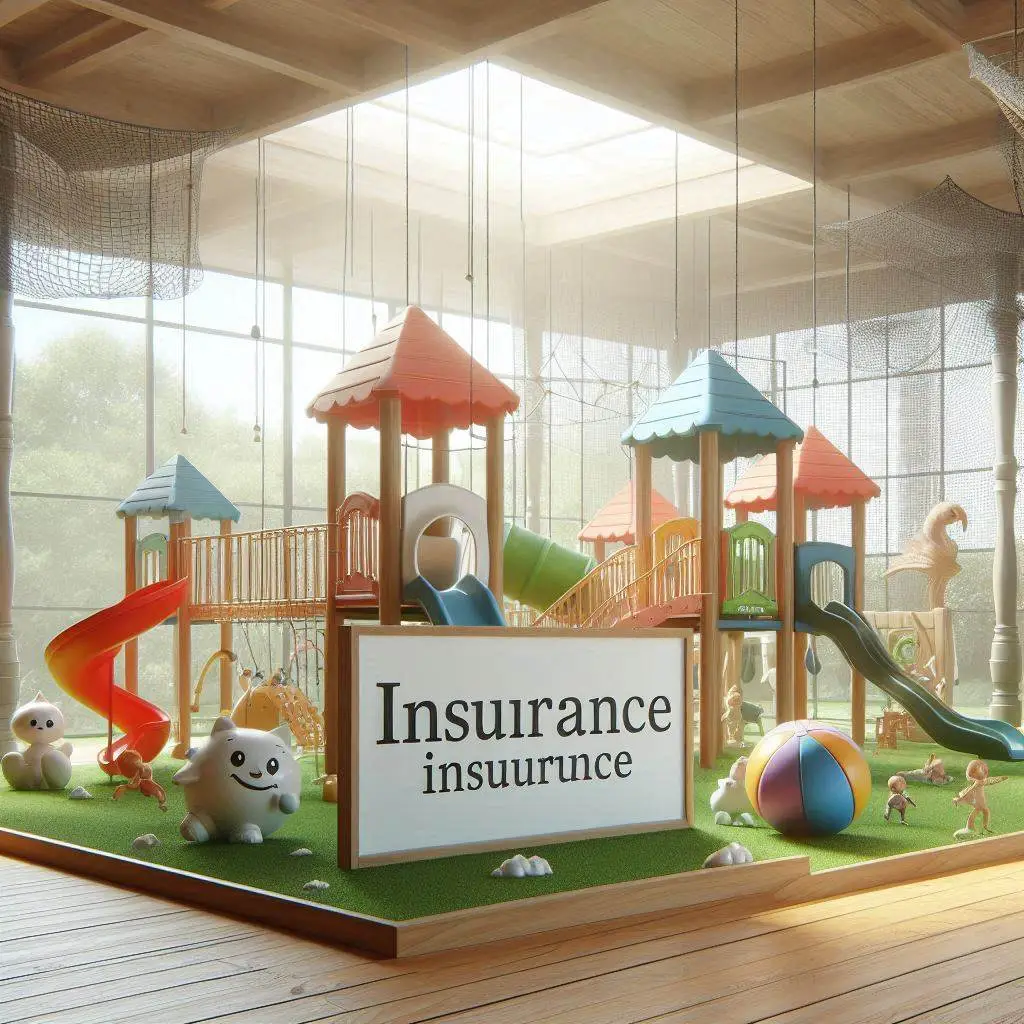Families with little children are coming to indoor playgrounds in record numbers. These lively areas provide children with a fun and safe place to play, meet new people, and burn off some steam. However, because of the high stakes and potential legal consequences, comprehensive insurance is necessary for every indoor playground operator.
Keeping possible accusations against your company at bay, including:
- Visitors’ injuries that occur on the property
- The building or its machinery sustains harm
- Injuries or illnesses sustained by workers
- Data breaches and cyber dangers
Types Of Insurance Coverage Needed For Indoor Playgrounds

Operating an indoor playground involves multiple risks, making it essential to have various insurance policies in place. Failing to secure adequate coverage can leave your business vulnerable to significant financial losses in the event of unexpected incidents or claims. Here are the key types of insurance coverage every indoor playground owner should consider:
General Liability Insurance
With general liability insurance, your company can safeguard itself from claims of injury to persons or property, damage to third-party property, or advertising harm. This essential coverage protects you from the financial burden of legal protection, settlements, or judgments resulting from accidents or incidents on your property.
Typical costs for general liability insurance vary based on factors such as:
- Size of your facility
- Number of visitors and employees
- Level of risk associated with your activities and equipment
Commercial Property Insurance
Insuring Businesses’ Real Estate This policy covers your indoor playground’s structure, furnishings, equipment, and inventory. Theft, vandalism, hurricanes, fires, and other covered perils might help pay for repairs or replacements.
Policy options may include:
- This type of insurance pays to replace damaged or destroyed property with new, comparable goods.
- Pays out the property’s depreciated value upon loss, also known as actual cash value coverage.
Workers’ Compensation Insurance
Compensation for Employees on the Job Employers are obligated by law in most states to maintain workers’ compensation insurance coverage. Workers’ compensation insurance helps pay for medical bills, time off work, and rehabilitation for those who get hurt on the job.
Costs are typically calculated based on:
- Total payroll
- Type of work performed (indoor playgrounds are generally considered higher risk)
- Claims history
Product Liability Insurance
Insurance Coverage for Products You might want to get product liability insurance if your indoor playground offers refreshments, toys, or other things for sale. Your company will be shielded from legal action if a customer suffers harm or property damage from using your goods.
Cyber Liability Insurance
Cyber liability insurance is a must-have in the modern digital world. It protects your company from occurrences that could compromise critical information or interrupt operations, such as data breaches or cyber-attacks, and the associated costs.
Policy options may cover expenses related to the following:
- Notification requirements
- Credit monitoring services
- Legal defense and liability costs
The insurance premiums for your indoor playground company may appear costly initially, but the alternative—not having coverage—could have devastating financial effects.
Navigating the Costs of Indoor Playground Insurance

Several essential elements will determine how much it will cost to insure your indoor playground company. Understanding these factors is crucial in creating a budget and getting affordable, suitable coverage. Insuring your home requires careful consideration of the following factors:
Location and Facility Size
The indoor playground’s location and size are essential factors affecting insurance premiums.
Playgrounds in densely populated regions are more likely to be victims of crime and have higher insurance premiums as a result. Similarly, insurance demands and prices are typically higher for larger establishments with more equipment and attractions.
Operational Risks and Safety Measures
Your indoor playground’s safety measures and the kinds of activities it offers can affect your insurance premiums. Insurers may be wary of risky activities like ball pits and climbing walls due to the potential for liability worries. On the other hand, employing strong safety measures like thorough inspections, knowledgeable staff, and explicit safety protocols can lower premiums and demonstrate risk management.
Claims History and Risk Management Practices
Former Claims and Strategies for Managing Risk Your company’s claims history is critical for insurance carriers when calculating prices. Insurance premiums can go up a notch if you have a history of serious injuries, accidents, or claims for property damage. Insurance companies are more likely to offer you lower rates if your company has a spotless claims history and proof of good risk management procedures.
Number of Employees and Payroll
Payroll and Employee Count Key variables impacting the cost of workers’ compensation insurance are the total payroll amounts and the number of employees. Because of the increased likelihood of job injuries and illnesses, premiums tend to be higher for businesses with larger payrolls and workforces.
Insurers may also consider:
- Age and condition of the facility and equipment
- Revenue and financial stability of the business
- Types of security measures in place (e.g., surveillance cameras, secure entry systems)
- Availability of on-site medical staff or facilities
Risk Evaluation of a Playground for Risk Management?

In addition to protecting your indoor playground company, robust risk management techniques may reduce insurance premiums. Your dedication to providing a safe environment for employees and visitors will be shown to insurers through your proactive detection and mitigation of risk efforts. Critical risk management tactics to think about are:
Comprehensive Safety Protocols
Detailed Safety Procedures Create and enforce thorough safety procedures that address every facet of your business. Examine and update these procedures often to ensure they remain efficient and under industry norms and laws.
Regular Inspections and Maintenance
Checks and Upkeep regularly: Inspect and regularly maintain all playground equipment, structures, and amenities. Take immediate action to resolve any issues that may pose a hazard or require repair or replacement. Keep meticulous records of all inspections and maintenance tasks that show your commitment to safety.
Staff Training and Supervision
Instruction and Management of Employees: Invest in comprehensive training programs for all employees, including subjects like responding to an emergency, first aid, and effective supervision. Ensure enough adult supervision by monitoring the play areas and ensuring everyone follows the regulations.
Incident Reporting and Documentation
Maintaining a Record of Incidents: Develop an open method for tracking and reporting mishaps, accidents, or near-misses on your property. Keep meticulous records that contain witness testimonies, photographs, and other pertinent evidence. This paperwork can be priceless when investigating problems, taking corrective actions, and defending against claims.
By applying these risk management tactics, you may show your insurance company that you’re serious about reducing risks and making the workplace safer for everyone. When you take the initiative, you can usually negotiate better insurance rates and terms.
In addition, many insurance companies provide discounts or bonuses to companies with good risk management strategies. By cooperating closely with your insurance provider and showing your commitment to protection, you can increase your chances of negotiating reduced rates or obtaining additional coverage options.
Remember that risk management is not a one-and-done deal but requires constant attention. Stay informed about the latest safety standards, consult with professionals in the field, and always be on the lookout for possible dangers. Your company and its finances can benefit from the commitment to safety, leading to reduced insurance premiums over time.
Read More: I Can’t Afford FR44 Insurance
Playground Insurance: Indoor Cost & Quotes

Selecting the right insurance coverage at an affordable cost is crucial for the success of your indoor playground business. To ensure you get the best value, shopping around and comparing policies from multiple insurance providers is essential. Here are some tips for effectively shopping for insurance and evaluating cost comparisons:
Working with Insurance Brokers or Agents:
Consider working with an experienced insurance broker or agent specializing in the indoor playground industry. These professionals can help you navigate the complex insurance landscape, identify appropriate coverage options, and negotiate with insurers on your behalf. Their expertise and industry knowledge can save you time and potentially secure better rates.
Obtaining Quotes from Multiple Providers
Obtaining Quotes from Multiple Providers Don’t settle for the first insurance quote you receive. Request quotes from multiple reputable insurance providers to ensure you comprehensively understand the market rates and coverage options available. Be prepared to provide detailed information about your business, such as the size of your facility, number of visitors, activities offered, and safety protocols in place.
Evaluating Coverage Options
Evaluating Coverage Options and Costs Carefully review and compare the coverage details, limits, deductibles, and exclusions outlined in each quote. While the premium cost is essential, ensuring adequate protection for your specific risks is equally crucial. Look for policies that align with your business needs and provide comprehensive coverage at a reasonable price.
Negotiating Rates and Discounts
Negotiating Rates and Discounts Feel free to deal with insurance providers. Discuss potential discounts or rate reductions based on factors like your good claims history, implementation of risk management strategies, or bundling multiple policies with the same insurer. Insurers may be willing to offer better terms, especially if you can demonstrate a commitment to safety and risk mitigation.
When evaluating quotes and coverage options, consider the following factors:
- Financial stability and reputation of the insurance provider
- Customer service and claims handling process
- Availability of additional endorsements or riders for specific needs
- Ease of policy management and communication with the insurer
It’s also important to review your insurance needs periodically and shop for new quotes as your business grows or circumstances change. Insurance rates and coverage options can fluctuate, so staying informed and proactive can help you secure the best possible protection for your indoor playground.
cost-saving strategies for indoor playground insurance
While securing comprehensive insurance coverage is essential for protecting your indoor playground business, the associated costs can add up quickly. However, there are several strategies you can implement to help manage and potentially reduce your insurance expenses without compromising on coverage. Here are some cost-saving tips to consider:
Bundling Insurance Policies
Many insurance providers offer discounts when you bundle multiple policies, such as general liability, property, and workers’ compensation insurance. By consolidating your coverage with a single provider, you may be able to take advantage of these bundling discounts and save money on your overall insurance costs.
Increasing Deductibles
Opting for higher deductibles on your insurance policies can lower premium costs. A deductible is the out-of-pocket amount before your insurance coverage kicks in. By agreeing to pay a higher deductible in the event of a claim, you can potentially reduce your annual premiums. However, consider your financial ability to cover the higher deductible amount if needed.
Implementing Risk Management Programs
As discussed earlier, robust risk management practices can help create a safer environment and potentially qualify you for insurance discounts or lower rates. Insurers view businesses with robust safety protocols and risk mitigation strategies as lower risks, which can translate into cost savings on premiums.
Exploring Industry-Specific Insurance Programs
Some insurance providers offer specialized programs or group plans tailored to the indoor playground industry. These industry-focused programs may provide more comprehensive coverage options and potential cost savings due to the pooled risk among similar businesses. Research and inquire about any such programs available in your area.
Other cost-saving strategies to explore include:
- Maintaining a good credit score (insurers may offer better rates)
- Paying premiums annually instead of monthly installments
- Regularly reviewing and adjusting coverage as your business needs change
- Exploring captive insurance options or risk retention groups
It’s crucial to balance cost-saving measures and ensure adequate business coverage. While reducing expenses is desirable, compromising on essential protection can leave you vulnerable to significant financial losses in case of a claim or incident.
Work closely with your insurance provider or broker to understand the implications of any cost-saving strategies and make informed decisions that align with your business’s unique needs and risk profile.
Legal aspects of safety in children’s play areas
Operating an indoor playground involves navigating a complex web of legal and regulatory requirements, including those related to insurance coverage. Please comply with these obligations to avoid costly fines, penalties, or even the inability to operate your business legally. Here are some fundamental legal and regulatory considerations to keep in mind:
State and Local Insurance Requirements
State and Local Insurance Requirements Different states and municipalities may have specific insurance requirements for indoor playground facilities. Some locations mandate certain types of coverage or minimum liability limits. Research the laws and regulations in your area to ensure your insurance policies meet all necessary criteria. Consulting with a local attorney or industry association can help you stay compliant.
Licensing and Zoning Regulations
Licensing and Zoning Regulations: In addition to insurance requirements, you must obtain the proper licenses and permits to operate your indoor playground legally. Zoning laws may also dictate where these facilities can be located within a given area. Failing to secure the necessary licenses or follow zoning regulations could lead to costly penalties or shutdowns.
Industry Standards and Best Practices
Industry Standards and Best Practices While not legally mandated, adhering to industry standards and best practices can help demonstrate your commitment to safety and professionalism. Organizations like the International Play Equipment Manufacturers Association (IPEMA) and the American Society for Testing and Materials (ASTM) provide guidelines and certifications that insurers may consider when evaluating your coverage needs and rates.
Other legal considerations include:
- Correctly classifying employees for tax and insurance purposes
- Complying with accessibility requirements (e.g., Americans with Disabilities Act)
- Obtaining necessary permits for events, food service, or other special activities
- Understanding liability implications for invited third-party vendors or contractors
It’s crucial to consult with legal professionals, such as attorneys specializing in business law and insurance regulations, to ensure you fully understand and comply with all applicable laws and requirements. They can also advise you on drafting appropriate waivers, disclaimers, and policies to protect your business further.
Keeping up with regulation changes is also essential, as laws and industry standards can evolve. Regularly review your insurance coverage and operations to maintain compliance and avoid potential legal issues or penalties.
By prioritizing legal and regulatory compliance, you protect your indoor playground business from potential legal consequences and demonstrate a commitment to safety and responsible operations, which can be viewed favorably by providers.
Conclusion
Securing the right insurance and implementing robust risk management practices are crucial for protecting your indoor playground business. Prioritise liability, property, workers’ comp, and cyber coverage. Location, facility size, safety measures, and claims history impact costs. Work with brokers, compare quotes, negotiate rates, and explore cost-saving strategies. Stay legally compliant and learn from others’ experiences. Insurance safeguards your investment, so make it a top priority. Conduct thorough research, consult experts, and take necessary steps to mitigate risks while providing families with a fun, secure environment.
Frequently Asked Questions
How do I write a business plan for an indoor playground?
To create a solid business plan for an indoor playground, start with an Executive Summary outlining the concept, target audience (families with children), and unique features like themed areas and play zones. Conduct thorough Market Research, analyzing competitors and trends in children’s entertainment, and identifying local demand.
Define your Target Audience and Customer Profile, such as children aged 1-10, and describe how your playground will meet their needs. Choose a Location close to schools or malls, and describe planned facilities like snack bars or party rooms.
In the Business Model, explain revenue sources like admission fees, memberships, and party bookings. Develop an Operations Plan covering staffing, equipment maintenance, and safety measures.
Your Marketing Plan should include online and local promotion strategies. In the Financial Plan, project costs, revenue, and profitability within 1-3 years. Finally, conduct a Risk Analysis, addressing safety, competition, and compliance with legal regulations.
Do I need insurance for soft play?
Yes, insurance is essential for any indoor playground or soft play business. It helps protect your business from potential liabilities, such as accidents or injuries that could occur on the premises. Key types of insurance include:
- Public Liability Insurance: Covers legal and medical expenses if a child or visitor is injured in your facility.
- Employer’s Liability Insurance: If you hire staff, this covers any claims made by employees for injuries or accidents that happen while working.
- Property Insurance: Protects your playground equipment, facilities, and inventory from damage due to fire, theft, or vandalism.
- Business Interruption Insurance: Provides compensation if your playground has to close temporarily due to unforeseen events, such as a natural disaster or equipment failure.
Before opening, check local requirements as insurance types and amounts may vary based on regulations.
How to open an indoor playground?
Begin by conducting thorough Research and Planning, focusing on your target market, local competitors, and industry trends. Identify what makes your indoor playground unique to stand out. Next, Find a Location that is spacious, accessible, and zoned for commercial use, with enough room for play areas, party rooms, and seating for parents.
Create a detailed Business Plan that outlines your playground concept, market, operational plans, and financial projections. Register Your Business, choosing a legal structure and obtaining necessary licenses and permits.
Design the Playground to offer a safe, engaging space with diverse activities like slides and sensory zones. Purchase Equipment that is durable, safe, and compliant with safety regulations. Establish clear Safety Protocols, and ensure staff is trained in first aid and supervision.
Hire Staff who are friendly and child-focused. Develop a strong Marketing Strategy with promotions and online presence. Finally, plan a grand Launch Event to attract customers and build engagement.

Justin Taylor is the creative force behind Insuranted.com, a premier destination for insightful and trustworthy insurance information. With a dedication to demystifying insurance complexities, Justin strives to equip readers with the knowledge they need to make smart, informed decisions.










